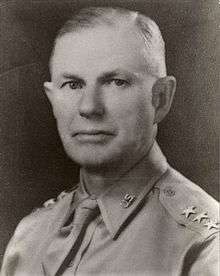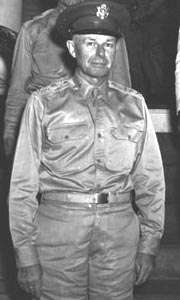Walter Short
Walter Campbell Short (March 30, 1880 – September 3, 1949) was a lieutenant general in the United States Army and the U.S. military commander responsible for the defense of U.S. military installations in Hawaii at the time of the Japanese attack on Pearl Harbor on December 7, 1941.
Walter Campbell Short | |
|---|---|
 Lieutenant General Walter C. Short | |
| Born | March 30, 1880 Alton, Illinois, U.S. |
| Died | September 3, 1949 (aged 69) Dallas, Texas, U.S. |
| Allegiance | |
| Service/ | |
| Years of service | 1902–1942 |
| Rank | |
| Commands held | 1st Infantry Division I Corps Hawaiian Department |
| Battles/wars | World War I World War II |
| Awards | Army Distinguished Service Medal |
Early life
Short was born in 1880 in Fillmore, Illinois. The son of a doctor, he graduated from the University of Illinois in 1901.[1]
He was commissioned a second lieutenant on March 13, 1902,[2] and assigned duty at the Presidio of San Francisco. He served in the Philippines and later Alaska, and took part in the expedition into Mexico with the 16th Infantry Regiment in 1916.[3] During World War I, he served on the general staff of the 1st Division and as assistant chief of staff for the 3rd Army.[2] After the war, Short became a member of the War Department General staff and served with the Far Eastern section of the Military Intelligence Division until 1924. He then attended the Army War College and after graduation served as a staff school instructor.[3] He commanded 1st Infantry Division from 1938 to 1940 and I Corps from January 1940 to January 1941. General George Marshall appointed him to the Hawaiian command on February 8, 1941. He earned the Distinguished Service Medal and was considered to have had a successful career at that time, especially in light of his promotions during peacetime.[2]
Japanese attack

On December 17, 1941, General Short was removed from command of the U.S. Army's Hawaiian Department as a result of the Japanese attack on the Hawaiian Islands. Short was ordered back to Washington, D.C. by Army Chief of Staff George C. Marshall. In disgrace, he was reduced in rank from his temporary rank of lieutenant general to his permanent rank of major general, since his temporary rank was contingent on his command.
On February 28, 1942, he retired from the Army and then headed the traffic department at a Ford Motor Company plant in Dallas, Texas. He briefly returned to active duty from October 3, 1945 to February 28, 1946. He retired in 1946 and died in 1949 in Dallas of a chronic heart ailment.[3]
Roberts Commission
The Roberts Commission, headed by U.S. Supreme Court Associate Justice Owen J. Roberts, was formed soon after the attack on the Hawaiian Islands. General Short, along with Navy Commander in Chief, U.S. Fleet and Pacific Fleet, Admiral Husband E. Kimmel, was accused of being unprepared and charged with dereliction of duty. The report charged that he and Kimmel did not take seriously enough an earlier war warning and did not prepare for an air attack at Pearl Harbor.
In a letter dated January 24, 1941, Secretary of the Navy Frank Knox advised the Secretary of War Henry L. Stimson that the increased gravity of the Japanese situation had prompted a restudy of the problem of the security of the Pacific Fleet while in Pearl Harbor. Knox wrote: "If war eventuates with Japan, it is believed easily possible that hostilities would be initiated by a surprise attack upon the fleet or the naval base at Pearl Harbor." The letter proceeded: "The dangers envisaged in their order of importance and probability are considered to be: (1) Air bombing attack (2) Air torpedo plane attack, (3) Sabotage, (4) Submarine attack, (5) Mining, (6) Bombardment by gunfire."[4]
Knox's letter stated the defenses against all but the first two were then satisfactory, described the probable character of an air attack and urged the Army to prepare for such an attack. It concluded with recommendations for the revision of joint defense plans with special emphasis on the coordination of Army and Navy operations against surprise aircraft raids. It also urged the conduct of joint exercises to train the forces to meet such raids.[4]
Stimson replied February 7, 1941, that a copy of the letter was being forwarded to Short, with direction to him to cooperate with the local naval authorities in making the suggested measures effective. Admiral Kimmel and General Short received copies of these letters at about the time they assumed their commands.[4]
The report found that had orders been complied with:
- the aircraft warning system of the Army should have been operating:
- the distant reconnaissance of the inshore air patrol of the Army should have been maintained;
- the antiaircraft batteries of the Army should have been manned and supplied with ammunition: and
- a high state of readiness of aircraft should have been in effect.
None of these conditions was in fact inaugurated or maintained for the reason that the responsible commanders failed to consult and cooperate as to necessary action based upon the warnings and to adopt measures enjoined by the orders given to them by the chiefs of the Army and Navy commands in Washington.[4]
The Roberts Commission was not a court martial proceeding or a judicial tribunal. Rather, the investigations were for fact-finding. There is generally no right to "due process", in the sense of a right to counsel and to cross-examine witnesses at a fact-finding investigation.[5]
Short's defense
In 1946 Short testified on his own behalf before Congress about the 1941 attack.[2] Unlike some of his predecessors in Hawaii, Short was more concerned with sabotage from Japanese-Americans on Oahu. This led to Army planes parked outside of their hangars so they could be more easily guarded. However, this made them easy bombing targets and many were subsequently destroyed on the morning of the attack.[2][4] In explaining his reasons for his instituting an alert against sabotage only (local "Alert One" level),[6] General Short stated:
- that the war warning message he received on November 27 contained nothing directing him to be prepared to meet an air raid or an all-out attack on Hawaii ("Alert Two" and "Three");[6]
- that he received other messages after the November 27 dispatch emphasizing measures against sabotage and subversive activities;
- that the dispatch was a "do-don't" message which conveyed to him the impression that the avoidance of war was paramount and the greatest fear of the War Department was that some international incident might occur in Hawaii which Japan would regard as an overt act;
- that he was looking to the Navy to provide him adequate warning of the approach of a hostile force, particularly through distant reconnaissance which was a Navy responsibility; and
- that instituting higher level alerts would have seriously interfered with the training mission of the Hawaiian Department.[7]
He also declared that he did not receive adequate warning and suffered from a lack of resources. He and his family attempted to get the Army to restore his rank of lieutenant general in the retired ranks on the basis that warnings from the War Department prior to the attack were vague and in conflict.[1] He requested, but did not receive, a formal court-martial.[1]
Controversies over findings
On May 25, 1999, the United States Senate passed a non-binding resolution exonerating Kimmel and Short by a 52 to 47 vote. The resolution stated they had performed their duties "competently and professionally" and that the Japanese attacks were "not a result of dereliction of duty." "They were denied vital intelligence that was available in Washington," said Senator William V. Roth, Jr. (R-DE), contending they had been made scapegoats by the Pentagon. Senator Strom Thurmond (R-SC) called Kimmel and Short "the two final victims of Pearl Harbor."[8] The resolution was originally attached as an amendment to the Department of Defense spending bill for FY2000 (S.1059) and cleared the Congress as a whole in October 1999, urging President Bill Clinton to restore Kimmel and Short to their full wartime ranks.[9] However, neither Clinton nor any of his successors acted on the resolution.
Admiral William Harrison Standley, who served as a member of the Roberts Commission, later disavowed the report, maintaining that "these two officers were martyred" and "if they had been brought to trial, both would have been cleared of the charge."[10]
Awards
| Army Distinguished Service Medal | ||
| Mexican Border Service Medal | World War I Victory Medal with three stars |
American Defense Service Medal with "Foreign Service" clasp |
| Asiatic-Pacific Campaign Medal with one star |
World War II Victory Medal | Legion d'Honneur (Officier) (France) |
Dates of rank
| No insignia in 1901 | Second Lieutenant, Regular Army: February 2, 1901 |
| First Lieutenant, Regular Army: April 4, 1907 | |
| Captain, Regular Army: July 1, 1916 | |
| Major, National Army: August 5, 1917 | |
| Lieutenant Colonel, Temporary: July 30, 1918 | |
| Colonel, Temporary: November 7, 1918 | |
| Captain, Regular Army: August 26, 1919 | |
| Major, Regular Army: July 1, 1920 | |
| Lieutenant Colonel, Regular Army: October 6, 1923 | |
| Colonel, Regular Army: October 1, 1933 | |
| Brigadier General, Regular Army: December 1, 1936 | |
| Major General, Regular Army: March 1, 1940 | |
| Lieutenant General, Regular Army: February 8, 1941 | |
| Major General, Regular Army: December 17, 1941 | |
| Major General, Retired List: February 28, 1942 | |
References
- Pearl Harbor 1941: The Day of Infamy by Carl Smith, Adam Hook, Jim Laurier.
- "History, Commanding Generals: United States Army, Pacific: Lieutenant General Walter C. Short". The United States Army. Archived from the original on March 9, 2013. Retrieved January 25, 2017.
- General Short, 69, Dies NY Times, September 4, 1949.
- Attack Upon Pearl Harbor by Japanese Armed Forces – 77th Congress, Senate Document No. 159.
- Edwin Dorn ADVANCEMENT OF REAR ADMIRAL KIMMMEL AND MAJOR GENERAL SHORT ON THE RETIRED LIST III. THE PEARL HARBOR INVESTIGATIONS
- Arakaki, Leatrice R. and Kuborn, John R. (1991). 7 December 1941: The Air Force Story, Pacific Air Forces Office of History. ISBN 0-912799-73-0, p. 19 (p. 5 in text)
- CONGRESS OF THE UNITED STATES, INVESTIGATION OF THE PEARL HARBOR ATTACK: REPORT OF THE JOINT COMMITTEE ON THE INVESTIGATION OF THE PEARL HARBOR ATTACK 79TH Congress SENATE DOCUMENT No. 244.
- PHILIP SHENON Senate Clears 2 Pearl Harbor 'Scapegoats', NY Times, May 26, 1999.
- Congress Backs Son's Fight to Return Admiral's Honor, Los Angeles Times, October 13, 1999
- Requesting the President to advance the late Rear Admiral Husband E. Kimmel on the retired list of the Navy to the highest grade held as Commander in Chief, United States Fleet

